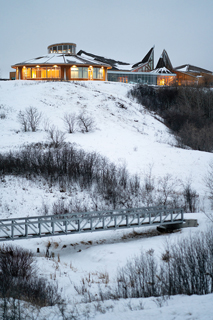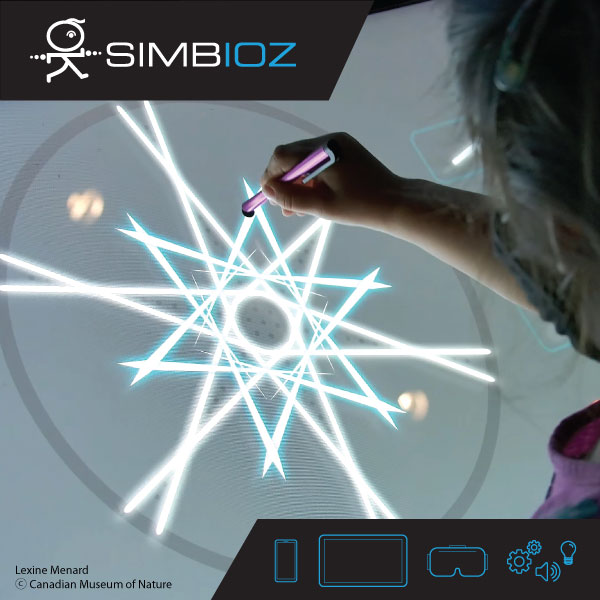Examining Indigenous-led Governance in Heritage Spaces
Stephanie Danyluk

Wanuskewin Heritage Centre in the Winter. Photo — Ashley George.
Indigenous peoples have been practicing governance over their heritage since time immemorial. The containment, control, and destruction of Indigenous peoples and their heritage included the widespread removal of ancestral remains, cultural belongings, and traditional knowledge, as shown in the Historical Considerations section of the report.
Governance in Indigenous-led spaces is often responding to colonial conditions while drawing on cultural values of the communities to whom they are responsible. Examining how Indigenous governance is implemented in three Indigenous heritage spaces—Haida Gwaii Museum, Wanuskewin Heritage Centre, and Woodland Cultural Centre—reveals that while there is no template for enacting Indigenous governance, though all spaces share a tendency towards centring accountability to a multitude of relationships and community responsibilities including culture, language, land, and ceremony.
Historical Context for Creation
With Indigenous political and grass-roots organizations building momentum into the latter half of the twentieth century, colonial control was resisted with a wave of activism, academic work and court cases asserting Indigenous self-determination over their cultural heritage. The National Indian Brotherhood (NIB) led the Indian Control of Indian Education movement, with a central focus on the importance of Cultural Centers. This movement gave rise to the formalizing of cultural centres across Indigenous Nations, including Woodland Cultural Centre, which was established in October 1972, under the direction of the Association of Iroquois and Allied Indians upon the closure of the Mohawk Institute Residential School (MI).
Similarly, the Haida Nation reasserted their self-determination over cultural heritage through the Haida Gwaii Museum. With the backdrop of the Calder Case, a key legal decision on the existence of Indigenous title, as well as other key lands and rights cases being fought in courts, the museum formed as a partnership between Indigenous and non-Indigenous people of Haida Gwaii. The museum opened in 1976. At the centre was the Haida’s assertion of self-determination over their cultural belongings and ancestors which, at the time, were still being removed from their lands.
The mounting assertion of inherent and treaty rights on the prairies alongside of the desire to promote cross-cultural understanding and partnership between Indigenous and non-Indigenous peoples backdrop the founding of the Wanuskewin Heritage Park. Although initiated by non-Indigenous founding bodies, First Nations peoples’ leadership for the site was central. Conversations started with the influential Hilliard McNab, a well-respected leader and powerful advocate for Indigenous governance and treaty rights. On the first Elder’s Council was another significant leader, Elder Senator Philomene Gamble, brought to the Council for her years of advocacy for Indigenous self-governance, education, and women’s rights.
Indigenous-led Governance Today
Today, governance at Woodland Cultural Centre emphasizes principles of reciprocity and intergenerational knowledge transfer. According to former long-time Executive Director Janis Monture, Woodland’s core values draw from core Hodinohsho:ni cultural teachings, with longhouse traditions adopted in the board approach. “Ideal governance looks at and uses the traditions of the people who run the space,” Monture says.
From the start, the Woodland Board of Directors were all of First Nations descent. Policy and guidance documents use culturally appropriate terminology and language. For example, Memoranda of Understanding are written in Mohawk and English languages. Hodinohsho:ni practices and traditions are reflected in the consensus-based decision-making board processes.
Overlapping accountabilities are built into Woodland’s governance, and includes being accountable to elected and traditional governments, the Confederacy, as well as to the faithkeepers and the community.
The intersections of accountability with different systems of checks and balances requires cultural competency, as many of these are passed down orally, Monture says. Oral traditions are present in Woodland governance, much of which involves spirituality and aspects of ceremonial knowledge that are “not written, but are engrained in our cultural ways,” Monture explained. “Everything is relational. It takes time, ongoing commitment, and reciprocity. Community relationship are not just government relationships.”
The Haida Gwaii Museum governance centres on Haida ways of being, particularly the firm cultural diplomacy of the Haida, who have the “profound mandate to build relationships on mutual respect, cooperation and trust,” as Executive Director Nika Collison explains.
Their approach includes the codification of Xaayda Ga Xaaynang.ngaay, Haida ways of being, to guide governance and operations of the museum. These are not laws, Collison clarifies, “but are instead values we strive for.” Particular to governance, Collison cites —informed collective decision—making that requires understanding all relationships and responsibilities, and the expertise of knowing where to go for counsel. Collison describes the process of the “Haida-ization” of the museum as shifting from “policies to protocols.”
The museum’s board of directors is mandated to be comprised of a 50/50 split in Haida and non-Haida directors. Their approach to Indigenous led governance emphasizes cooperation and partnership between Indigenous and non-Indigenous groups, recognizing the shared responsibility of all people to protect and celebrate heritage.
The governments and groups to which the Haida Gwaii Museum is accountable are many and overlapping. This includes formal accountabilities to the Council of Haida Nations, the House of Assembly and Haida citizens, hereditary chiefs, as well as the language and repatriation committees.
This “Haidaization” takes place alongside of decolonization initiatives, and Collison notes that understanding Canadian legal and regulatory systems is required to navigate, reconsider, and supersede these with Haida approaches.
Established as a site of cultural stewardship for future generations, Wanuskewin has an expansive concept of stewardship at the core of its governance, which includes education as part of decolonization. Cy Standing, a member of the Wanuskewin Elder’s Council, explains: “For a long time we were in hiding. Our histories outside of colonization were not being told.”
Governing bodies at Wanuskewin are responsible to the communities they represent, including local Indigenous urban and on-reserve First Nation communities. Chief Executive Officer Darlene Brander emphasizes, “I work here as a steward to honor the past, thrive in the present and realize our future. I work here, knowing that a legacy for the current and upcoming generations will be left for them.”
The Wanuskewin Board of Directors, comprised of Indigenous and non-Indigenous directors, receives core guidance from the Elders Council. Board Chair Candace Wasacase-Lafferty explains that the Wanuskewin Board of Directors, Elders, and executive work together to centre Indigenous leadership. As a community-led space, “this is a place to connect to our ancestors, the park’s renewal is our renewal,” Wasacase-Lafferty says.
Models of governance in these spaces have developed partially in response to colonial circumstances and partially to reflect core cultural ways of the Indigenous communities they represent. The historical context behind Indigenous-led governance of heritage spaces today is a confluence of the preservation and endurance of cultural knowledge, the history of the assertion of Indigenous rights and self-determination, as well as decolonization initiatives in response to the long and lingering colonial policies and practices. Today, Indigenous-led management of heritage spaces offers us some understanding of the balance of accountability, reciprocity, and cultural competency that Indigenous-led governance requires.
Stephanie Danyluk is Senior Manager, Community Engagement with the CMA, supporting the work to promote Indigenous self-determination in museum and heritage spaces. She is a public historian and researcher with extensive experience in community engagement.
With contributions from: Darlene Brander, Candace Wasacase-Lafferty, Vance McNab, Ernie Walker, Cy Standing, Nika Collison, Janis Monture.
